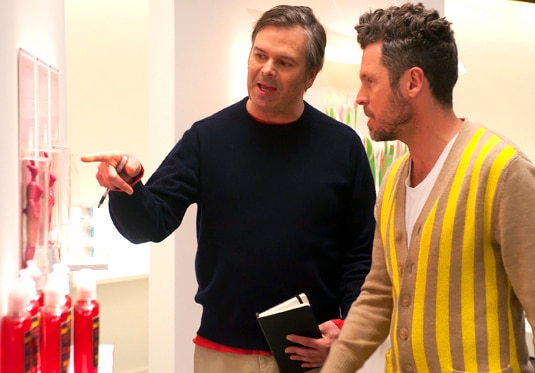Pop Touched Me, Too
Bill discusses why Young's work was so successful (and tells us the correct way to pronounce Kymia's name).

Pop art was the original mash-up, and while Andy Warhol is remembered as the king of pop, there were many others involved in the movement from Ed Ruscha to Roy Lichtenstein. Our guest judge on this challenge was a major coup for us, because Rob Pruitt embodies what pop art means today by hosting an annual art awards a la the Oscars and making slick glittery paintings a mile deep. I called Kymia's installation an example of product displacement. It shined a light -- quite literally -- on issues of environmentalism and consumerism without reading like an AdBusters cover. The fluorescent lights recalled Jeff Koons' pre-new work, and I agree with The Sucklord that her decision to go topless here surprised me. On a side note, I confess that for the first couple of episodes I had trouble pronouncing Kymia's name until someone explained that phonetically it sounds like leukemia without the "leu." Terrible comparison, but hey, it worked.
Young's Prop 8 billboard reminds us that simplicity is the ultimate sophistication, and Lola dismissing it as political art you see everywhere in California was a disappointment. Street art at its best has the ability to make real change. Does anyone doubt that Shepard Fairey's Obama poster helped him get elected president? The other aspect of Young's piece, which didn't fully read on TV, was how much of a hub it became in the gallery with people writing messages on the back. The participatory quality made everyone a stakeholder in Young's artwork. Rob Pruitt wrote "Will You Marry Me?" in Sharpie and I accepted. (Please don't tell his boyfriend Jonathan Horowitz, another great conceptual artist.)
My problem with Dusty's garbage can was that his message came off like someone wagging a finger in your face and not the call to arms we need in a country full of couch potatoes.
Jazz-Minh's commentary on celebrity culture was half-baked. I think it's fair to say that America invented what we call fame today. You need to push the conversation beyond Britney Spears' frozen smile. Inserting herself into the picture was risky, because it revealed the fine line between introspection and narcissism. (I'm talking perception here, not necessarily Jazz-Minh's intent.) I had a similar issue with Leon's floor piece in that the communication was fractured and reductive. I applaud his inclusion of the Facebook and Twitter logos as corporate icons of the 21st century, but to crack their facade didn't feel like enough of a transformation to save this piece. Plus the American flag is such a loaded symbol that unless you can really put your stamp on it, maybe this image too easily becomes a cliche.
Michelle faced a near identical challenge depicting the Coca Cola can, her reasoning being that Coke Zero is different than the original painted by Warhol. But to me it's just Diet Coke men can feel manly about drinking. Her decision to paint the soda can on a phone screen was the most interesting to me. In the world we live in surrounded by so many invisible filters, perhaps the mediation is the message.



